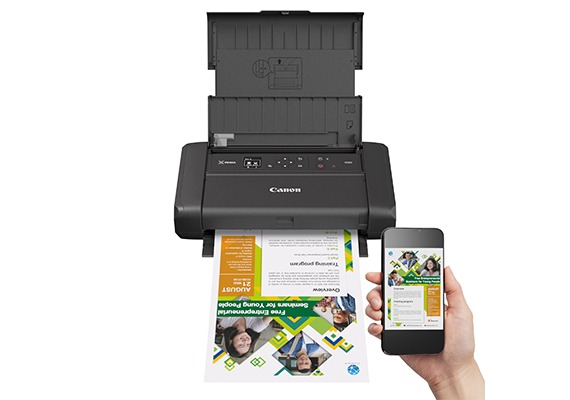(Pictured above: Karsten Huster, president & CEO NT-ware; Kristen Goldberg, director, enterprise & desktop solutions marketing, BICG, Canon U.S.A.; Mark Sinanian, senior director, solutions ,marketing, Canon Solutions America, and Eric Hawkinson, vice president marketing, Canon Solutions America, discuss Canon’s approach to the evolving office landscape.)
One of the challenging aspects of covering an industry event is when we are asked what do you think at the conclusion of the event? Fortunately, not everyone asks that question, but when they do, some of us find it best to roll out some little white lies about how valuable it was, how compelling the content was, and blah, blah, blah. Admittedly, some of us will tell it exactly like it is when asked that question, and even put it in writing after the fact. Some of those colleagues don’t get invited back.
I am happy to report that no white lies or evasive answers were necessary about Canon’s Media & Analyst Event on February 12. It was a morning of solid content packed into four hours of presentations, including compelling insights from customers and a dealer. The four-hour program was followed by optional half-hour 1:1 briefings with Canon executives, enabling those of us who took advantage of these briefings to take a deeper dive into the morning’s content.
With all the information, it’s a challenge narrowing my list down to 10 takeaways, but here goes.
Canon’s dealer channel is doing just fine. Revenue in the channel grew by 2% in 2018, representing the seventh consecutive year of what Canon deemed “steady growth.” In an industry that’s seen its struggles and where some consider flat growth a positive, we view that as a respectable increase.
Canon rocks the production print world. If growth is any measure of rocking a world, then Canon is rocking it in production print. Francis McMahon, senior vice president BICG Océ products PPS marketing & support, reported that 2018 was the best year Canon had in the history of production printing. The company grew revenue 102% year over year; operating profit was 102% of budget; the company held the top market share for the eighth straight year in the U.S., placing 92 continuous feed (CF) device. Canon saw its hardware placements grow 108% vs. market growth of 103%, growing in every one of its production print product categories. In addition, Canon captured 60 net new accounts compared to 15 the previous year, and experienced 18% YOY growth with the VPi300 with 40 units sold. In the production world where boxes are big and prices high, those were impressive numbers for 2018.
Business Information Communications Group (BICG) printing business had a darn good year. Sam Yoshida, executive vice president and general manager, Canon U.S.A., reported 9% growth on the enterprise side of the business, 29% in production, 12% in commercial print (inkjet), 21% for display graphics systems, and 12% in large format. He did not provide numbers for the SMB space, but we surmise the 2% growth in its dealer channel covers much of that segment.
Growth opportunities. The four strongest growth opportunities identified by Canon executives include cloud/security, production, vertical markets (education, healthcare, finance and insurance), and workflow automation.
Canon expands its security strategy. One of the hottest trends in the imaging world is security and Canon seems to be on top of that trend. Its initiatives encompass device security, print security, document security, information security, and cybersecurity. Peter Kowalczuk, president Canon Solutions America, discussed how Canon is not only focusing on hardware security but in securing the document from the beginning of its life to the end of its life. New introductions to Canon’s security portfolio include PhishLine from Barracuda, a third-party SaaS program that allows customers to run phishing exercises to expose weaknesses in the organization, identifying which employees click on suspect emails, and then use that information to educate employees so they are no longer as vulnerable to phishing threats. Another third-party program available from Canon is EventSentry software that helps IT customers manage the end points in their network to ensure they are protected against outside threats. These new introductions complement last December’s introduction of PrinterLogic, a third-party enterprise management program that facilitates secure, server-less printing.
Canon MFPs evolving to become a cloud-connected device. This is consistent with what we’ve been seeing from the other MFP vendors and that’s enhancing the capabilities of their MFPs and tying them into the cloud. This is a big initiative for Canon as well and expect to see more MFPs from Canon with workflow and security enhancements tied into the cloud.
Canon’s subscription model for uniFLOW. Subscription models are not a foreign concept to businesses anymore and Canon is looking to leverage that acceptance with a SaaS subscription model for its various uniFLOW printing solutions, including the on-premise version, the online cloud-based version, and a new hybrid version. The hybrid version is designed to meet the needs of customers who want to move some processes into the cloud, but aren’t ready to move everything into the cloud, and might never be ready to do so.
Oh the Techmanity! Don’t you love it when companies coin new words? Canon’s is Techmanity. The definition of Techmanity, according to Kristen Goldberg, director, enterprise & desktop solutions marketing, BICG, Canon U.S.A., is the marriage of technology and humanity, taking Canon’s strong products and technology and backing it with its network of partners, its channels, and its expertise in the industry. As she explained, “What’s interesting about all the changes we’re seeing in technology, one component that’s often overlooked is the human element. We have customers and they’re real people with goals and objectives, and they’re leveraging the technology to create communications that are better informed, more efficient, more secure, and the advances we’re seeing in technology is helping them achieve that. It’s beyond just imaging solutions but looking at how we can communicate and share information and how Canon can help in that overall process. The technology is one part of the equation and the second part is the human element.”
Canon identifies industry challenges. Many of the challenges outlined by Mason Olds, senior vice president & general manager, sales, BICG, synch with our own findings from our annual dealer survey. The four big challenges identified by Olds include attracting a changing workforce to our industry; declining page volume and cost per copy; the continued push to color, solutions, and higher volume users; and diversification. While we’re still unclear how Canon is looking to overcome the first challenge by making the imaging industry attractive to young job seekers, the new technologies, services, solutions, and initiatives outlined during the four-hour event provided a roadmap of how Canon is addressing those challenges.
Canon’s high hopes. At these events we don’t expect presenters to be anything less than optimistic. Whether it was Yoshida, Goldberg, Olds, Kowalczuk, McMahon, and other Canon executives or Greg Martin president of Ray Morgan Company, acknowledging that his dealership is still a copier company and that it expects to double sales in production and wide format this year, everyone had a good reason to be optimistic for 2019.
Access Related Content
Visit the www.thecannatareport.com. To become a subscriber, visit www.thecannatareport.com/register or contact cjcannata@cannatareport.com directly. Bulk subscription rates are also available.




